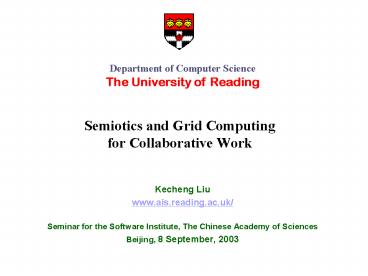Semiotics and Grid Computing for Collaborative Work - PowerPoint PPT Presentation
1 / 16
Title:
Semiotics and Grid Computing for Collaborative Work
Description:
Department of Computer Science The University of Reading Semiotics and Grid Computing for Collaborative Work Kecheng Liu www.ais.reading.ac.uk/ Seminar for the ... – PowerPoint PPT presentation
Number of Views:177
Avg rating:3.0/5.0
Title: Semiotics and Grid Computing for Collaborative Work
1
Semiotics and Grid Computing for Collaborative
Work
Department of Computer Science The University of
Reading
- Kecheng Liu
- www.ais.reading.ac.uk/
- Seminar for the Software Institute, The Chinese
Academy of Sciences - Beijing, 8 September, 2003
2
Agenda
- Grid technology and applications
- Virtual organisations and collaborative work
- An organisational semiotics view
- Modelling the human aspects in Grid computing
- Summary and future work
3
Grid technology and applications
- Grid technology
- infrastructure for distributed and collaborative
computing - common resource-access and operational services
across virtual organisations - Applications - key features
- Multi actors, large scale distributed and
collaborative work - Sharing resources
- infrastructural resources
- value adding resources
- Extended form of CSCW
4
Grid technology and applications (cont.)
Grid computing components
Fabric level Middleware Development
tools Applications
Local resources managements Operating systems,
job queuing, libraries, TCP/IP Network
resources management Computers, networks,
storage systems, data resources Distributed
resources bound services Communication,
sign-on and security, process management, data
access, Languages, libraries, debuggers,
monitoring, resource brokers, Most in form of
portals, in scientific computation, engineering,
e-science, e-business, e-government,
5
Virtual Organisations
- A temporary network of autonomous organisations
- cooperate based on complementary competencies
- connect their information systems to those of
their partners - aiming at developing, making, and distributing
products in cooperation - Based on the metaphor of virtual memory of a
computer (Mowshowitz 1994)
6
Virtual Organisations (cont.)
- Distribution of resources
- resources, competences and demands
- Collaboration between actors
- member organisations, organisational components
or individuals - Shared communication protocols.
- not only use the same language (syntax of the
protocols), but also understand the meaning
(semantics of communications). - Mechanism for task managements and executing
coordinated actions - mechanism for swapping between jobs, delivering
resources, controlling multi-threaded operations
across several sites.
7
Organisational Semiotics
- Semiotics is the study of signs
- examines the nature and properties of all kinds
of signs - Signs
- basic units for human and machine-based
communication - Organisational Semiotics
- to study the properties and behaviour of signs in
organisational contexts and business practice - To treat an organisation as an information system
- Information is created, stored, and processed for
communication and coordination and for achieving
the organisational objectives.
8
Organisational Semiotics (cont.)
The Semiotic Framework (Stamper 1973, 1996)
9
Modelling the Human Aspects
Semantics
- Functions of semantics and lifetime management in
Grid (Foster et al. 2002) - A mapping between computational behaviour and
human behaviour, based on business domain. - Semantic models define the resource management
mechanism for detection, allocation, creation and
lifetime management of Grid services.
10
Modelling the Human Aspects (cont)
Pragmatics
- Concerned with business context
- Involves modelling the roles and access to Grid
services - responsibility, obligation, right and privilege.
- Identification of roles of all registered users
- major collaboration processes determine the
resource access and control model - Link the resource access and control model
11
Modelling the Human Aspects (cont)
Social aspect
- Social, organisational and cultural rules on the
use of Grid - Institutional policies and accepted common
practice in collaborative work - Perceived benefits and drawbacks
- Identify essential rules and incorporate them
into the e-infrastructure - Promote the sharing of resources and protect the
individual institutions interest and integrity.
12
Modelling the Human Aspects (cont)
Integrated modelling of semantic, pragmatic and
social aspects
13
Modelling the Human Aspects (cont)
- Link the Integrated model with the Grid
infrastructure - Enable members within the Grid environment
- act as if in a virtual organisation
- share across multiple heterogeneous platforms for
collaboration.
14
Modelling the Human Aspects (cont)
Portal
Application services (on the Internet)
SPS model
Information /data resources (on the Internet)
15
Modelling the Human Aspects (cont)
- User agents to capture and interpret the users
requests. - The SPS model
- an ontology representation of responsibility and
institutional norms, - defines the users roles and behaviour.
- Application services
- the SPS model
- Specifies all the services available on the Grid,
- Plus responsibility social/institutional
constraints. - Information/data resources
- the SPS model - location and availability of
resources with extension of social/institutional
constraints. - The portal reference to the SPS model which
serves as policies for defining levels of access - responsibility, obligation, privilege and right)
- allocate and manage the Grid services.
16
Summary and future work
- The Grid computing
- Great infrastructure for collaborative work in a
secure and trusted environment - Virtual organisations become reality
- Human aspects are essential as part of the
infrastructure - Semantics, pragmatics, and social issues
- Organisational Semiotics offers an useful
approach - Representing the human aspects in work practice
- Incorporating the human aspects to Grids
http//www.ais.reading.ac.uk/































